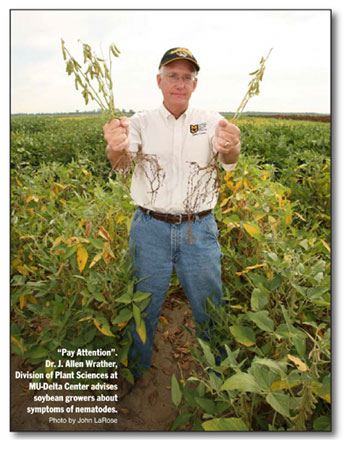Nematode Control In Soybeans
Faster Way To Check For Root Knot Nematode
PORTAGEVILLE, MO.
Dr. Allen Wrather, Plant Pathologist, MU Delta Center, advises soybean growers to pay attention; specifically to the look of their soybean crop. “Nematodes will cause symptoms of injury that are most often noticed by stunt of the plants,” he said.
“Both nematodes can, in severe situations, cut susceptible soybean yields by up to 70 percent. That’s in the most severe situations, but we have seen 20 bushel yield losses over lots of acres.”

Soybean cyst nematode and root knot nematode have been causing problems in Missouri for some time. “The root knot nematode is pretty much restricted to this part of the state because it is a warm soil loving nematode. It can’t tolerate the cold up in north Missouri. Soybean cyst nematode however has spread out all over almost all of Missouri and most other soybean producing states. Cold weather during the winter will reduce populations of both nematodes some. That is good because the fewer nematodes at planting the lower the yield loss. That’s old information. We’ve learned, through research over the years, almost all of it supported by Soybean Farmer Checkoff, that soybean cyst nematode can be controlled by planting resistant varieties and by crop rotation.”
Wrather has new information. “Crop rotation works better in south Missouri than in north Missouri. We’ve found that these nematodes only have about one life cycle, from egg to adult which lays eggs in north Missouri and then it goes dormant. By planting a corn crop, few eggs hatch and go through a suicide hatch. It’s a suicide hatch the year the corn is planted.”
“In south Missouri, these nematodes may hatch even through a good bit of the winter until the soils freeze. So crop rotation works better here and further south. Crop rotation doesn’t work for root knot nematode control because it attacks corn, grain sorghum and cotton. The only way to control root knot nematode is to plant resistant varieties; unfortunately there are very few available. A farmer can use certain seed treatments to protect the soybeans against both nematodes,” explained Wrather.
VOTiVO by Bayer and Avicta by Syngenta are seed treatments applied prior to planting and will provide some short-term protection according to Wrather. “The main issue is to identify whether these nematodes are causing yield loss. Old information is that the farmer can send soil samples in and have them analyzed. The new information is sampling this way for root knot won’t work during the winter. It can only be used from June through October. We found, through research, the best way to identify root knot nematode problem areas is to dig up roots near harvest. If root knot is there you will see the knots on the root. It’s rapid, it’s less expensive than soil analysis and it’s more reliable in indication what problems would be present next year.”
“Our research indicates the best time to dig roots and determine if root knot is present is to dig those soon before harvest. Soon after harvest the roots begin to rot and it’s hard to get them out of the soil and still see the knots. Right before harvest or immediately after also works great for cotton but since cotton root rots more slowly, you can even delay digging cotton roots through November,” said Wrather.
The important factor for farmers is to aware if the nematode is present. Farmers sometimes get busy with their crop production, harvest and marketing and they forget to periodically check soils and plants to see if these nematodes are causing problems. Once the nematodes are there it’s there forever because they will live on some weeds. The cyst nematode won’t attack as many different plants as root knot but they’ll both be there forever.
“Farmers with yield monitors should pay attention to areas of the field where yields are less than expected, those areas are where at times samples should be taken in order to determine why the crop is yielding poorly. Consider that nematodes may be part of that problem. If they are present, be sure to take action for the most profitable production,” added Wrather. Δ
REGINA LAROSE: Associate Editor, MidAmerica Farmer Grower